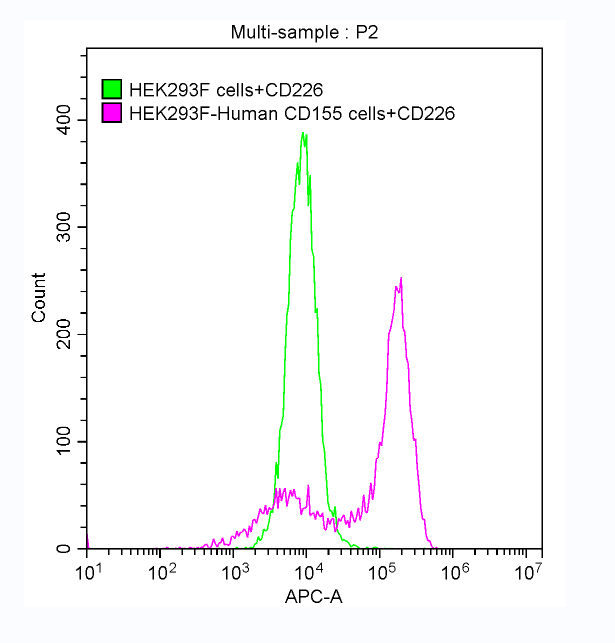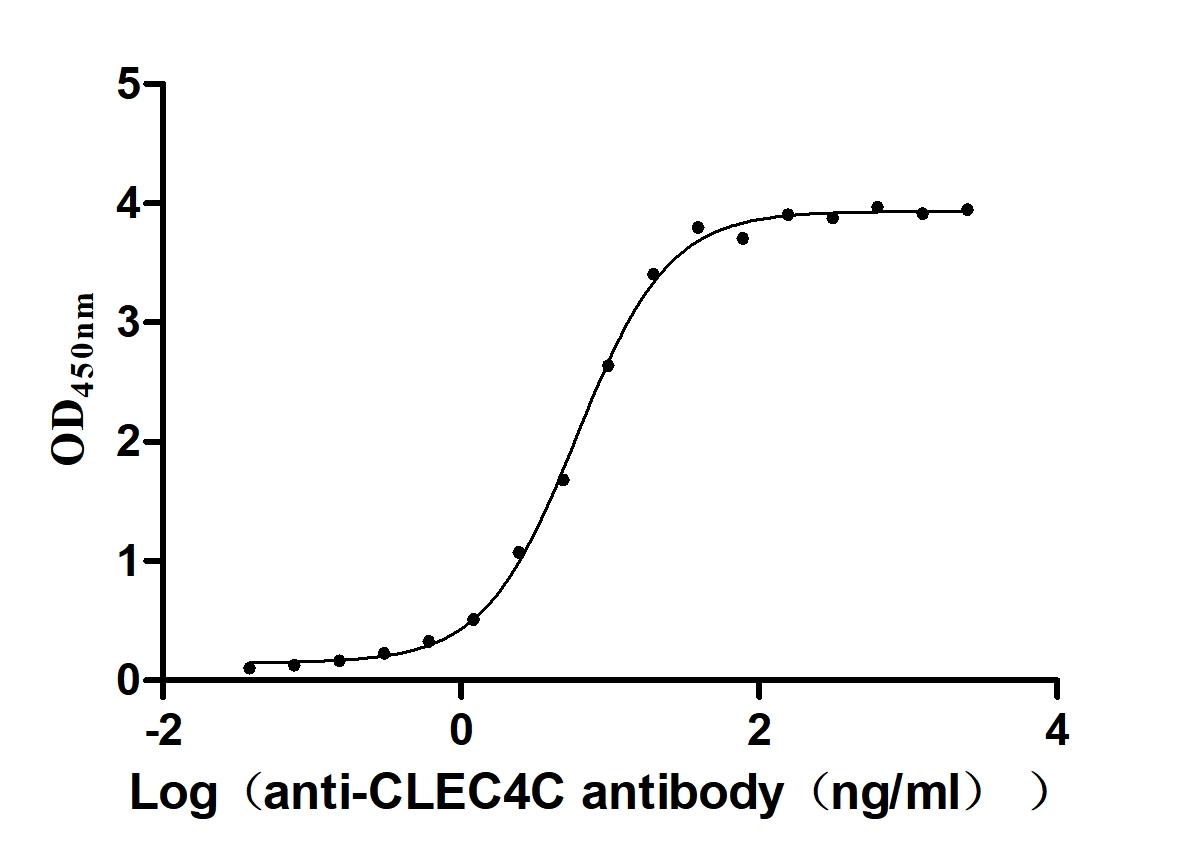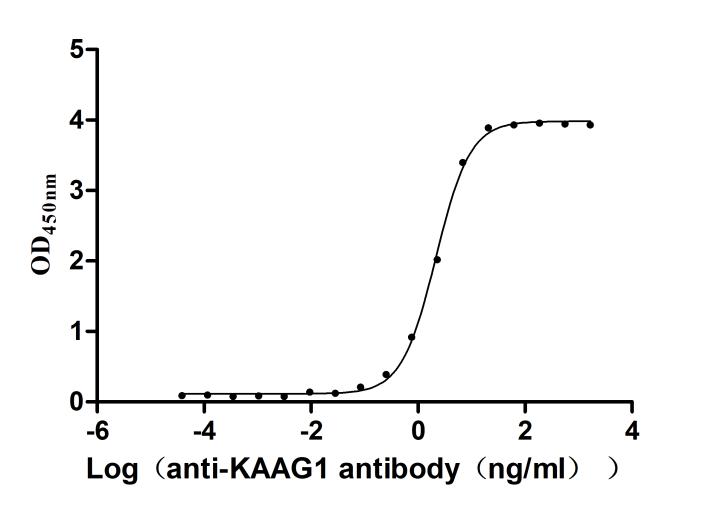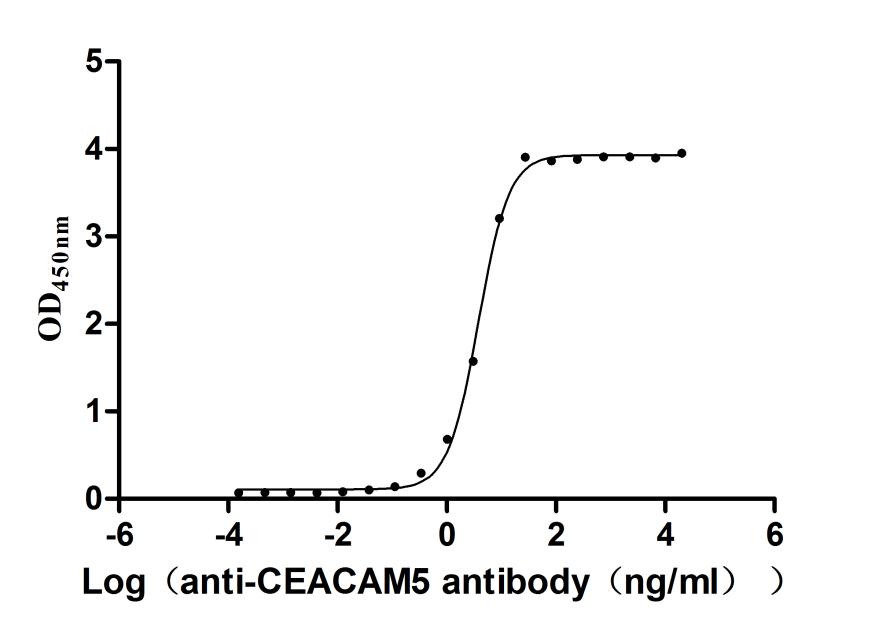Recombinant Mouse Paternally-expressed gene 3 protein (Peg3), partial
-
中文名稱:小鼠Peg3重組蛋白
-
貨號(hào):CSB-EP668889MO-B
-
說明書:
-
規(guī)格:
-
來源:E.coli
-
共軛:Avi-tag Biotinylated
E. coli biotin ligase (BirA) is highly specific in covalently attaching biotin to the 15 amino acid AviTag peptide. This recombinant protein was biotinylated in vivo by AviTag-BirA technology, which method is BriA catalyzes amide linkage between the biotin and the specific lysine of the AviTag.
-
其他:
產(chǎn)品詳情
-
純度:>85% (SDS-PAGE)
-
基因名:Peg3
-
Uniprot No.:
-
別名:Peg3; Kiaa0287; Pw1Paternally-expressed gene 3 protein; ASF-1
-
種屬:Mus musculus (Mouse)
-
蛋白長度:Partial
-
蛋白標(biāo)簽:Tag?type?will?be?determined?during?the?manufacturing?process.
The tag type will be determined during production process. If you have specified tag type, please tell us and we will develop the specified tag preferentially. -
產(chǎn)品提供形式:Lyophilized powder
Note: We will preferentially ship the format that we have in stock, however, if you have any special requirement for the format, please remark your requirement when placing the order, we will prepare according to your demand. -
復(fù)溶:We recommend that this vial be briefly centrifuged prior to opening to bring the contents to the bottom. Please reconstitute protein in deionized sterile water to a concentration of 0.1-1.0 mg/mL.We recommend to add 5-50% of glycerol (final concentration) and aliquot for long-term storage at -20℃/-80℃. Our default final concentration of glycerol is 50%. Customers could use it as reference.
-
儲(chǔ)存條件:Store at -20°C/-80°C upon receipt, aliquoting is necessary for mutiple use. Avoid repeated freeze-thaw cycles.
-
保質(zhì)期:The shelf life is related to many factors, storage state, buffer ingredients, storage temperature and the stability of the protein itself.
Generally, the shelf life of liquid form is 6 months at -20°C/-80°C. The shelf life of lyophilized form is 12 months at -20°C/-80°C. -
貨期:Delivery time may differ from different purchasing way or location, please kindly consult your local distributors for specific delivery time.Note: All of our proteins are default shipped with normal blue ice packs, if you request to ship with dry ice, please communicate with us in advance and extra fees will be charged.
-
注意事項(xiàng):Repeated freezing and thawing is not recommended. Store working aliquots at 4°C for up to one week.
-
Datasheet :Please contact us to get it.
靶點(diǎn)詳情
-
功能:Induces apoptosis in cooperation with SIAH1A. Acts as a mediator between p53/TP53 and BAX in a neuronal death pathway that is activated by DNA damage. Acts synergistically with TRAF2 and inhibits TNF induced apoptosis through activation of NF-kappa-B. Plays a role in regulating maternal behavior and offspring growth.
-
基因功能參考文獻(xiàn):
- Transcription driven by the alternative promoter U1 is required for oocyte-specific DNA methylation setting on the Peg3 locus. PMID: 28925797
- The mutants with abrogation of the two paternally expressed genes, Peg3 and Usp29, showed a significant decrease in growth rates for both males and females, while the mutants with biallelic expression of Peg3 and Usp29 resulted in an increased growth rate of female mice only PMID: 29734399
- The Peg3 locus may have evolved to an imprinted domain to cope with both parental and sexual conflicts. PMID: 27901122
- PW1-positive cells were highly proliferative in comparison to PW1neg endothelial cells and were able to form colonies when seeded at clonal dilution. PMID: 28090691
- PW1/Peg3 is a reliable marker of the full population of follicle stem cells and reveal a novel CD34- bulge stem-cell population. PMID: 27862634
- Strand-specific CpG hemimethylation, a novel epigenetic modification functional for genomic imprinting, has been demonstrated for Peg3 gene. PMID: 28605464
- orientation of the Peg3-ICR may play no role in its allele-specific DNA methylation PMID: 28719641
- The results indicate that PW1 is a co-regulator of the beta cell cycle and can thus be considered a novel therapeutic target in diabetes. PMID: 27130279
- This study demonstrated the existence of a novel population of resident adult cardiac stem cells expressing PW1(+) and their involvement in fibrotic remodeling after MI. PMID: 28774379
- promoters of Peg3 derive sexually biased and tissue-specific expression patterns PMID: 27711129
- Our study also identified the imprinting control region (ICR) of H19 as a genomic target. According to the results, PEG3 binds to a specific sequence motif located between the 3(rd) and 4(th) CTCF binding sites of the H19-ICR. PEG3 also binds to the active maternal allele of the H19-ICR. PMID: 27824289
- These results support a general role for Pw1/Peg3 in the regulation of body growth but not maternal care and lactation. PMID: 27187722
- Data indicate that a set of cis-regulatory motifs and corresponding trans factors that may be critical for the transcriptional regulation of the Peg3 (Paternally Expressed Gene 3) domain. PMID: 27104590
- Data show that bisperoxovanadium (BpV) treatment induces specific epigenetic modifications at the promoter regions of genes associated with stem cell fate, including Sca-1 and Pw1. PMID: 26672000
- 5'-GTGGCAGT-3'is a DNA-binding motif of PEG3. PMID: 26692216
- the milk letdown process was impaired in nursing females with the Peg3 mutation in the mammary gland, but not in the hypothalamus suggesting that Peg3's roles in the milk letdown process are more critical in the mammary gland than in the hypothalamus. PMID: 26640945
- Study reports, for the first time, the bi-allelic expression of Peg3 in specific areas of mouse brain. PMID: 25774914
- these results demonstrated that paternally expressed Peg3 controls maternally expressed Zim1 as a trans factor. PMID: 25265264
- Oocytes vitrification could lead to the loss of DNA methylation of imprinted genes (H19, Peg3, and Snrpn) in mouse blastocysts, which is mainly caused by the reductions of DNMTs after vitrification of oocytes. PMID: 25064401
- The down-regulation of Igf2 and Peg3 imprinted genes in adipocytes may be involved in the paternal transmission of high-fat diet-induced obesity. PMID: 24416415
- Mutant model revealed potential roles of Peg3 in reproduction. Female heterozygotes produced a much smaller number of mature oocytes than the wild-type littermates, resulting in reduced litter sizes. PMID: 24391757
- we have unveiled a mechanism for a secreted proteoglycan in inducing Peg3, a master regulator of macroautophagy in endothelial cells PMID: 23798385
- these results confirm PEG3 as a DNA-binding protein controlling specific target genes that are involved in distinct cellular functions. PMID: 23078764
- Data show that deletion of the Peg3-DMR (Peg3-differentially methylated region) caused global changes in the imprinting and transcription of the Peg3 domain. PMID: 22394678
- PW1 serves as an invaluable marker for competent self-renewing stem cells in a wide array of adult tissues PMID: 21709251
- Data indicate that regulation of Peg3 expression in blastocysts is controlled, at least in part, by Mta2. PMID: 20720167
- PEG3/Peg3 genes in human and mouse are imprinted, with preferential expression from the paternal allele in placenta. PMID: 11331620
- Peg3/Pw1 is a mediator between p53 and Bax in DNA damage-induced neuronal death PMID: 11943780
- Imprinted expression was linked to the differential methylation of a region (DMR) upstream of the Peg3 gene. PMID: 15112106
- PW1 plays role in mediating skeletal muscle stem cell behavior which in turn is critical for postnatal muscle growth and homeostasis. PMID: 15893971
- transcriptional up-regulation of most of the imprinted genes within the Peg3 domain PMID: 17067777
- CypA has an epigenetic function in protecting the paternal allele of Peg3 from DNA methylation and inactive histone modifications PMID: 17071620
- findings report that p53 is required for the TNFalpha-mediated inhibition of myogenesis in vitro & contributes to muscle wasting in response to tumor load in vivo; also PW1 and p53 participate in a positive feedback regulatory loop in vitro PMID: 17182869
- The roles of the cis-elements, conserved sequence element (CSE) and YY1-binding sites, in the regulation of Peg3 expression were identified. PMID: 18068135
- Peg3 appears to have evolved to regulate the experience-dependent preference for receptive females, an adaptive trait that would enhance male reproductive success and so potentially increase paternal transmission of this paternally expressed gene PMID: 18823153
- The decreasing expression of Peg3 with age was due primarily to decreased expression per cell rather than a decreased number of expressing cells. PMID: 19036884
- Conserved Sequence Element 2 (YY1 binding sites),functions as an activator for Peg3 transcription, while Conserved Sequence Element 1 acts as a repressor for the transcription of both Peg3 and Usp29. PMID: 19068137
- The neuronal and behavioral deficits seen in mice lacking a functional Peg3 gene are mediated by increases in the incidence of early neonatal apoptosis in brain. PMID: 19224563
- PEG3 imprinted domain of humans, cows, and mice contains differing numbers of differentially methylated regions (DMR), but the PEG3-CpG island is the only DMR that is conserved among these three species. PMID: 19397955
- disruptions to Peg3 influences aspects of female behavior that are critical for mediating maternal effects on offspring development, such as postpartum licking/grooming, and that effects of Peg3 are dependent on the maternal genetic background PMID: 19485553
- Peg3/PW1 is a p53 induced gene whose product interacts with Siah1 (also induced by p53) and can mediate cell death when co-expressed with Siah1. PMID: 10681424
- Peg3/PW1 binds to TRAF2 and can participate in TNFalpha mediated activation of NFkappaB. PMID: 9500555
顯示更多
收起更多
-
亞細(xì)胞定位:Nucleus. Cytoplasm.
-
蛋白家族:Krueppel C2H2-type zinc-finger protein family
-
組織特異性:Brain, glial cells, neurons, skeletal muscle, uterus and placenta. In the placenta it found in all trophoblast cells.
-
數(shù)據(jù)庫鏈接:
Most popular with customers
-
Recombinant Human CD226 antigen (CD226), partial (Active)
Express system: Mammalian cell
Species: Homo sapiens (Human)
-
Recombinant Human Interleukin-17A (IL17A) (T26A) (Active)
Express system: Baculovirus
Species: Homo sapiens (Human)
-
Recombinant Macaca fascicularis C-type lectin domain family 4 member C(CLEC4C), partial (Active)
Express system: Mammalian cell
Species: Macaca fascicularis (Crab-eating macaque) (Cynomolgus monkey)
-
Recombinant Human Kidney-associated antigen 1 (KAAG1) (Active)
Express system: E.coli
Species: Homo sapiens (Human)
-
Express system: Mammalian cell
Species: Macaca mulatta (Rhesus macaque)



-AC1.jpg)












